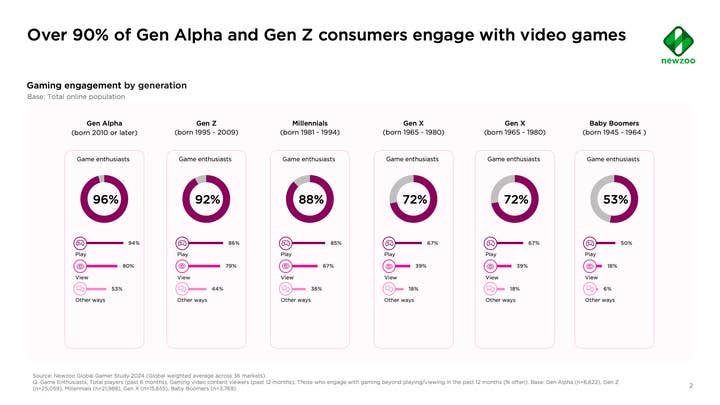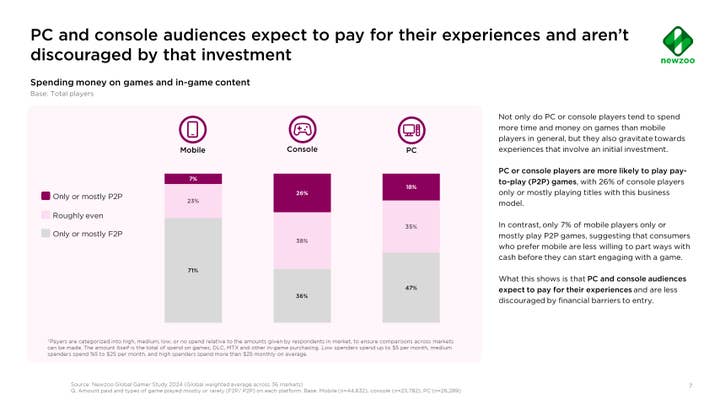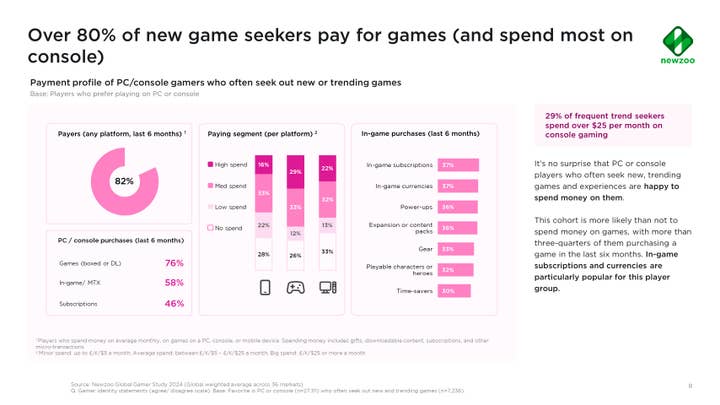Video games now embraced by all post-war generations
The data firm reveals insight into who is playing games in latest report
The stereotype of the lone, young male gamer has long since been banished, but the latest consumer research by Newzoo suggests that engagement with video games is now so widespread that even your average Baby Boomer is more likely to be a gamer than not.
A new Global Gamer Study entitled How Consumers Engage With Games Today from the consumer insights team at Newzoo suggests that a majority of the Baby Boomer generation – 53%, to be precise – engage with video games. Baby Boomers are classed as people born between the years of 1945-1954.
‘Engaging’ is classified as doing one or more of the following within the last 12 months: playing games, viewing games content, visiting online games communities, listening to games podcasts, attending games conventions, discussing video games with family and friends, or a number of other associated activities including those who ‘often’ follow video games channels online.
Unsurprisingly, the number of gamers within any given generational demographic increases in line with a decrease in age, climbing to 72% of Gen X (born between 1965-1980), 88% of Millennials (1981-1994), 92% of Gen Z (1995-2009) and 96% of Gen Alpha (2010 or later).

Among the most engaged demographic, Gen Alpha, those who are classified as ‘game enthusiasts’ even spend more time (5.2 hours per week on average) engaging with games than any other activity, including even the mighty social media. “This underscores how gaming has become mainstream and, for each new generation that gets into gaming, leads the way forward for media and entertainment culture,” the report states.
Games Rule the World
In terms of overall ubiquity, the Global Gamer Study – which surveyed over 73,000 consumers across 36 markets – found that 85% of online consumers worldwide are considered to be ‘game enthusiasts’ who engage with the hobby through playing, viewing, owning and/or social behaviour. Additionally, 80% of global consumers actually play video games.
Across the three youngest and most engaged demographics, the somewhat ambiguous ‘adventure’ genre was cited as most popular, with named examples being Minecraft, Fortnite, Call of Duty and Grand Theft Auto. The two older demographics, however, are less engaged with reaction-based action titles and instead gravitate toward puzzle games.
Drilling down into Gen Z in particular, there are some notable differences observed between gender segments. Gen Z males skewed toward adventure, battle royale, shooter, sports and fighting titles while females eschewed ‘sports’ releases in favour of puzzles. While non-binary and other genders again chose adventure as their preferred genre, this group also gravitated toward role playing and simulation releases.
“When you split the generation by gender identity, you find more similarities than differences," the report explains. "Adventure remains the favourite genre across gender identities, with fighting and 'shooter' games also making the top five. The gap between the share of male, female, and other identities who prefer fighting games, for instance, is not great enough to say that a new fighting title should target only male players. Most importantly, the gender balance as it pertains to favourite genres becomes more balanced as you look at younger generations.”
Wibbly Wobbly Timey Wimey
Mobile gaming has, of course, played a huge role in bringing games to the mainstream, though it may be of little surprise that the most dedicated gamers in terms of hours and minutes can be found on PC and console. 2.1 hours are on average spent playing games per day for both PC and console players, with that time spread across fewer, longer sessions than the more numerous but shorter time mobile gamers are engaged.
As a result, the non-mobile formats are in turn where you’ll find the hobby’s biggest spenders. Adds Newzoo: “More than half of console players are medium or high spenders, spending between $5 and $25 or more per month on gaming-related purchases.
“Each platform employs varying monetization methods. The type of players each platform attracts, though, and how they segment more specifically, also plays a key role in spending patterns. PC and console players are more likely than mobile players to spend on various combinations of titles, DLC launches and content, microtransactions, and other in-game purchases.”

PC and console players are also far more comfortable to pay upfront for an experience, with 18% and 26% respectively playing only or mostly premium titles. This compares to just 7% of mobile players, where the vast bulk of attention is given to free-to-play releases. In total, 71% of mobile gamers play only or mostly F2P games compared to 38% of console players and 47% on PC.
Newzoo also notes that the younger the data skews, the higher the share of female and non-binary players can be counted among the premium game segment, showing that “paying audiences are growing more diverse with every passing gamer generation.”
Hey Big Spender
14,502 games were released on Steam alone in 2023, according to SteamDB. Obtaining a number for mobile game releases in the same period is difficult, although it’s almost certainly considerably more. All of which makes the fact that just 66 games accounted for 80% of all play throughout 2023 even more striking.
Despite this, a demonstrable hunger for new experiences does exist. Newzoo says that 31% of PC and console players “often seek out and try new or trending games”. Of these gamers, over a third play on all three platform types (PC, console and mobile) and play an average of over seven hours per week. This group skews male (62%), is predominantly Gen Z and Millennial (76%) and has an average age of 27.4 years old.
A big reason for publishers and developers to engage with these ‘new game seekers’ is that they spend, with 82% having dropped cash on the hobby within the last six months. 76% have invested in buying physical or digital titles outright, 58% on MTX and, in what is a sign of the times, 46% pay for a games subscription of some kind. In fact, subscriptions and in-game currency are the first and second largest in-game spend for this cohort respectively.

And if you’re a developer wondering which feature is the single most attractive to this lucrative group, by far the most popular is good graphics, with 38 % citing visuals as the element that excites them the most.
Interestingly, what many may think of as the traditional core markets for games – the US, Japan and the UK – are not among the regions where new game seekers are most prevalent. Instead, this group are most likely to reside in China, India, Thailand, Egypt, Saudi Arabia and Vietnam, where 35% of players fall into this classification. This compares to 25-29% in the US, 20-24% in the UK and less than 15% in Japan (which is found in the very bottom tier).
All this and more can be found in the full report – head over to Newzoo’s website for more information.